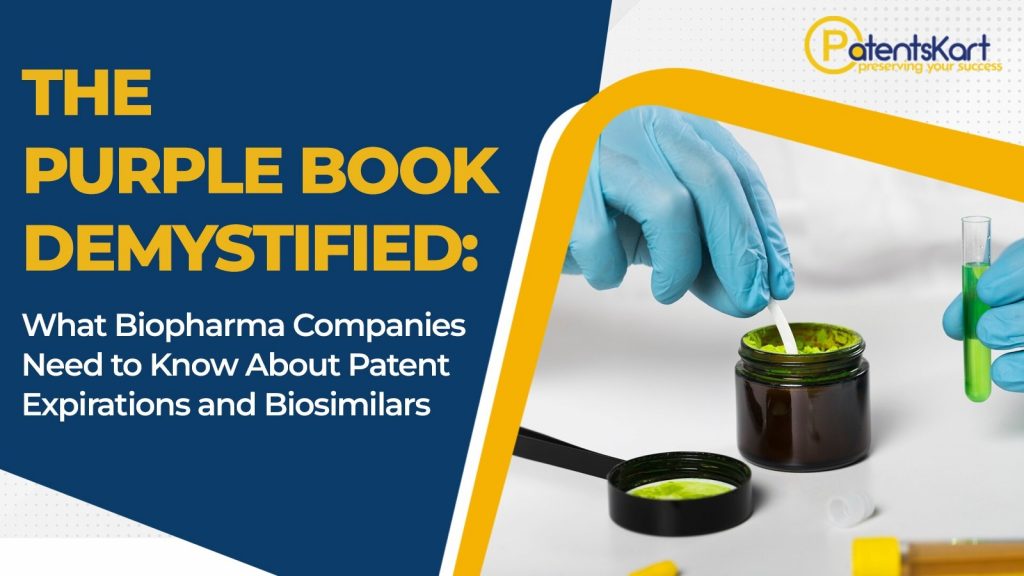In the fast-paced world of biopharmaceuticals, staying ahead of patent expirations and the rise of biosimilars is crucial for maintaining a competitive edge. For biopharma companies, understanding the nuances of patent law and biosimilar regulations is not just important—it’s essential to safeguard investments, drive innovation, and plan future strategies. One of the key tools that help industry professionals navigate this complex landscape is the Purple Book.
In this blog, we’ll demystify the Purple Book, explain its role in patent expirations, and dive into the growing importance of biosimilars. Plus, we’ll look at some real-world examples to make sure you walk away with a solid understanding of how to make the most of this resource.
What is the Purple Book?
The Purple Book is a comprehensive and authoritative guide published by the U.S. Food and Drug Administration (FDA). Officially known as the “List of Licensed Biological Products with Reference Product Exclusivity and Biosimilarity or Interchangeability Evaluations,” this resource is indispensable for anyone in the biopharma sector. The Purple Book lists all biological products approved by the FDA, and most importantly, it includes critical information about biosimilars and reference products.
The book gets its name from the distinct purple color of its cover, which helps it stand out among other FDA resources. Think of it as a roadmap for navigating the world of patent expirations, biosimilars, and the complex regulatory processes involved in bringing a biosimilar product to market.
What Are Biosimilars?
Before diving deeper into the Purple Book, let’s quickly clarify what biosimilars are and why they’re so important.
A biosimilar is a biologic medical product that is almost identical to an already-approved reference biologic (the originator product). Unlike generic drugs, which are chemically identical to their branded counterparts, biosimilars are similar but not identical to their reference products. This is due to the complexity of biologics, which are large molecules derived from living organisms.
Biosimilars offer biopharma companies the potential to reduce costs and provide broader access to critical medications, especially in markets where patents for blockbuster biologic drugs are nearing expiration. Biosimilars are crucial to ensuring continued innovation in the biopharma industry while also promoting more affordable options for patients.
How the Purple Book Helps with Patent Expirations
Biopharma companies face a constant challenge of managing patent expirations, especially in the biologic space. Once a biologic’s patent expires, generic versions—like biosimilars—can enter the market, often at a significantly lower cost. This can mean reduced revenue for the originator company, especially if the biosimilar is approved and priced competitively.
The Purple Book is an invaluable tool for tracking patent expiration dates and understanding when biosimilars may be poised to hit the market. It provides a list of licensed biological products and includes key information, such as:
- Biosimilarity evaluations: Whether a biosimilar has been approved as similar to its reference product.
- Exclusivity periods: The period during which the originator biologic is protected from biosimilars.
- Patent challenges: Legal battles surrounding patent validity that can impact market entry for biosimilars.
This information helps companies anticipate market shifts and plan accordingly. For instance, if a competitor is developing a biosimilar for a biologic approaching patent expiration, a company may choose to innovate further, invest in additional research, or adjust pricing strategies to maintain market share.
Patent Expirations and Their Impact
Let’s take a look at some real-world examples to illustrate how patent expirations impact the biopharma market and how the Purple Book can help.
Example 1: Humira (Adalimumab)
Humira, one of the world’s top-selling biologic drugs, is a treatment for autoimmune diseases like rheumatoid arthritis and Crohn’s disease. Humira’s patent expiration is one of the most anticipated events in the biopharma world.
The patent for Humira expired in 2016, but its exclusivity protections lasted longer due to ongoing patent litigation. This gave AbbVie, the company behind Humira, extra years of exclusivity before biosimilars could enter the market.
Thanks to the Purple Book, biopharma companies and investors were able to track the approval of Amjevita—the first biosimilar for Humira—and its eventual market entry in 2023. AbbVie’s strategies for dealing with this eventual competition have included the development of their own newer biologics, as well as aggressive pricing strategies.
Example 2: Herceptin (Trastuzumab)
Herceptin, a treatment for HER2-positive breast cancer, is another example of how patent expirations create opportunities for biosimilars. Herceptin’s patent expired in 2019, paving the way for biosimilars to enter the market.
The first biosimilar to Herceptin, Ogivri, was approved by the FDA and entered the market in 2018, much earlier than some predicted. The Purple Book allowed companies to follow these regulatory developments, which helped predict shifts in market share for the original Herceptin and its biosimilars.
For biopharma companies, these examples show that patent expiration doesn’t just represent a loss of exclusivity—it’s an opportunity to innovate, create new drugs, and prepare for increased competition.
The Role of the Purple Book in Biosimilar Strategy
For biopharma companies, especially those involved in the development of biosimilars, the Purple Book is a crucial tool for planning biosimilar entry strategies. By providing insight into existing biologic products and their exclusivity periods, companies can:
- Evaluate biosimilar market entry timing: The Purple Book allows you to monitor when a patent is set to expire or when a competitor’s biosimilar is likely to be approved.
- Understand regulatory requirements: The book outlines the FDA’s evaluation of biosimilars, including data requirements and approval processes.
- Identify potential competitors: It helps you spot which reference biologics have biosimilars in development or already licensed.
The Purple Book is essential for competitive intelligence and ensuring that biopharma companies are aware of key developments that could impact their product pipelines.
Conclusion: The Purple Book’s Growing Importance
As the biosimilars market continues to expand, biopharma companies must stay on top of patent expirations and market dynamics. The Purple Book is a crucial resource for achieving this, providing a comprehensive guide to biosimilars and their corresponding reference products.
By using the Purple Book, companies can better navigate the complex regulatory and patent landscape, anticipate competition, and align their strategies for sustained success. With the rise of biosimilars, the Purple Book is more important than ever in helping biopharma companies understand patent expirations and stay ahead in a competitive and evolving industry.
Remember, in the world of biopharmaceuticals, knowledge is power—and the Purple Book is one of your most powerful tools!







